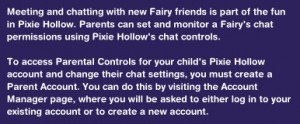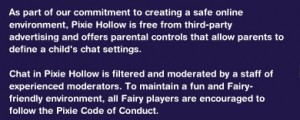 Today I decided to try my hand at something slightly different, or at least different from Second Life, which I have come to abhor, but I’ll stop there so I don’t rant. So today I made an avatar for myself from Pixie Hollow. My name is Hale Rivercloud and I am a sparrow-man. I have an awesome little green suit and fancy-shmancy little wings that I can use to fly around and collect things like spider webs, berries, and flowers for trade. I will admit that I felt somewhat sleazy being in a virtual world for children much younger than myself. It is for this reason that I refrained form taking part in any chatting or “friendly” behaviour.
Today I decided to try my hand at something slightly different, or at least different from Second Life, which I have come to abhor, but I’ll stop there so I don’t rant. So today I made an avatar for myself from Pixie Hollow. My name is Hale Rivercloud and I am a sparrow-man. I have an awesome little green suit and fancy-shmancy little wings that I can use to fly around and collect things like spider webs, berries, and flowers for trade. I will admit that I felt somewhat sleazy being in a virtual world for children much younger than myself. It is for this reason that I refrained form taking part in any chatting or “friendly” behaviour.
Once I had my fill of this fabulous fairy land, I logged out and went in search of privacy and security information for the site and the “virtual space” in which children take part. I ended up coming across parental information. The information provided for parents related to security and chat settings, since this seems to be the main way that children would be “preyed” upon while in Pixie Hollow. As Meyers et al. (2010) write:
The challenge in our current childhood landscape is that any risk is perceived as unacceptable. We appear to live in a risk-averse culture that works not just to reduce unnecessary risk, but also to eliminate the slightest possibility of harm to children (Byron, 2010).
 The information put forth by Disney seems to be sometimes overly protective in nature, bringing attention to their moderators and monitors a number of times. The chat is filtered through moderators at all times within the game, thus hindering the communication in some ways. Perhaps this is for safety of the children, but there are ways to monitor without necessarily interfering in word choice. Maybe I’ll just end up being a horrible parent, but I don’t think that monitoring children to such an extreme is always helpful.
The information put forth by Disney seems to be sometimes overly protective in nature, bringing attention to their moderators and monitors a number of times. The chat is filtered through moderators at all times within the game, thus hindering the communication in some ways. Perhaps this is for safety of the children, but there are ways to monitor without necessarily interfering in word choice. Maybe I’ll just end up being a horrible parent, but I don’t think that monitoring children to such an extreme is always helpful.

But it’s not only safety and security issues involved here. There are suddenly more limitations on children participating in the online environment. They lose control of their own behaviour because of parental and adult interference. I can’t help but feel that this is a bad thing. Perhaps I’m only saying this because I don’t have children or because I haven’t suffered from online issues of bullying or abuse, but I feel that limiting freedom is something that is complex and must be very, very carefully considered.
Meyers et al. also address the issue of what can happen to ideas of freedom when adults attempt to constantly monitor and inform online social behaviour of children and youth.
Efforts to eliminate exposure to risk may limit opportunities for young people to develop essential cognitive and metacognitive strategies (Livingstone, 2009). Donovan and Katz (2009) argue that children are informed social actors and that attempts by adults to monitor their online behavior and filter their websites has a chilling effect on children’s and youth’s privacy and free speech.
This post has been very limited in scope, but it’s my experience and my reactions so I obviously can’t cover everything that I would like from the article in the Journal of Virtual Worlds or in the Livingstone chapter. Perhaps I will make another small post or add some comments at a later time, but this is all for now. Thanks for listening!


